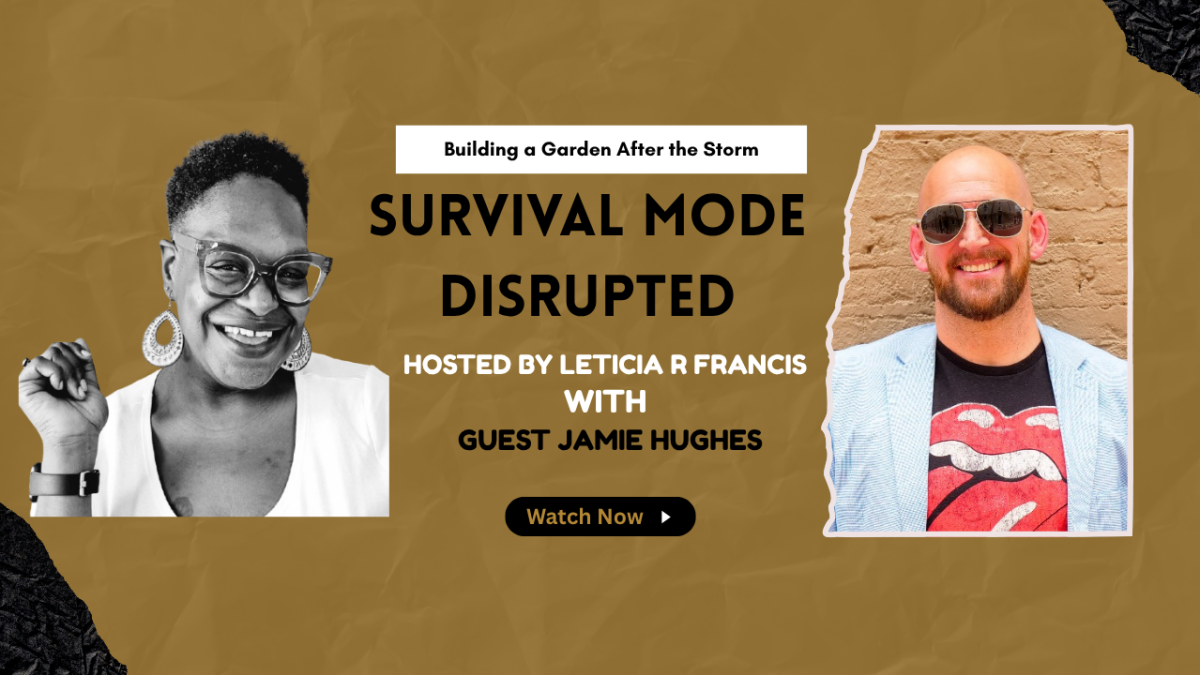Building a Garden After the Storm

From grief to grounded: Jamie shows how awareness, reprogramming, and reinvention turn survival mode into a life that can finally hold you.
If you’ve ever tried to outrun your past by becoming “the strong one,” pull up a chair.
Jamie Hughes shows up with accolades—social psychologist, author, trauma recovery coach, published researcher. On paper, he’s “doing amazing, sweetie.” In the body? A history stitched with grief, dismissal, and a nine-year-old boy told not to cry when his mother died.
That’s survival mode: when your nervous system gets stuck in danger while the world applauds your discipline.
Jamie names it plainly: survival mode is your mind and body trying to predict and prevent pain. Hypervigilance masquerading as wisdom. Control dressed up as “I’m just being careful.” And it touches everything—sleep, relationships, work, the way you read every room for exits and every face for threat.
This is the long walk out—Self-Awareness, Reprogramming, Reinvention—told through Jamie’s story and offered to yours.
The Cost of Surviving (When What You Needed Was to Be Held)
-
Loss without a landing. At eight, a Saturday cartoon is interrupted by the sentence that splits a life: “Your mother isn’t coming home.” Shock locks the body. Tears have no translator yet.
-
A home without welcome. He’s sent to a father he’s never met. From day one: you’re an intruder, not a son. When he finally cries, a step toward comfort is stopped by the order to “be a man.” Translation: Your pain is a problem. Put it away.
-
Darkness carried forward. Clinical depression by eighteen. A suicide attempt. The first time anyone says, “This is an illness, not a weakness.”
What happens next is why this episode matters: Jamie decides to study the very thing that almost swallowed him—psychology, trauma, the nervous system. He chooses to turn toward the wound with open eyes.
That choice is the hinge of healing.
Phase 1 — Self-Awareness: Call the Pattern By Its Name
Self-awareness is brutal and liberating: I wasn’t “dramatic.” I was grieving. I wasn’t “needy.” I was never met.
For Jamie, awareness sounded like these truths:
-
“I learned early that honesty equals punishment. That’s why I disappear in conflict or overreact to keep from being abandoned first.”
-
“Hypervigilance isn’t intuition. It’s my body rehearsing danger.”
-
“My ‘I’ve got it’ is a shield. Inside is a boy who never got to fall apart.”
Self-awareness begins in the body: the jaw that aches from grinding, the insomnia that won’t quit, the chest that doesn’t fully exhale. Your physiology is the historian of your life.
Try this: Finish the sentence, “When I tell the truth, I expect…” Whatever comes up is the contract survival mode made with your nervous system. Now you can rewrite it.
Phase 2 — Reprogramming: Stop Making Your Nervous System Carry the Whole House
Reprogramming is not pretending. It’s practice.
Jamie didn’t just “think positive.” He rebuilt how he relates—to himself, to love, to repair.
What it looked like:
-
Attachment honesty: “I want you to fix my pain” became “I can name my pain and hold it. If you want to meet me here, we can repair together.”
-
Boundary rehab: Truth without punishment. “This hurt me,” full stop—not a test, not a trap.
-
Emotional precision: Learning to experience emotions instead of outsourcing them for immediate relief.
-
Body-first regulation: Sleep hygiene, breathwork, movement, nourishment—because dysregulated bodies do not negotiate well.
-
Therapy with discernment: If a clinician minimizes your trauma, that’s not “tough love”—it’s misattunement. You can leave.
-
Parenting with accountability: Apology as skill, not shame. Letting kids keep their feelings—and their boundaries—without mistaking that for disrespect.
-
Resilience on purpose: Teaching loss and repair (not just wins) through small, safe practice—games someone loses, conversations no one rushes to fix.
Reprogramming mantra: I won’t abandon myself to keep peace that costs me my personhood.
Phase 3 — Reinvention: Build the Garden (Even If the Butterflies Don’t Show Up Today)
Jamie’s favorite parable: Don’t chase butterflies. Build a beautiful garden. If they come, they come. If they don’t—you still have a place to sit and breathe.
Reinvention isn’t a rebrand. It’s architecture:
-
Identity anchored in truth, not performance. You are not impressive to deserve comfort; you are human, therefore deserving.
-
Relationships that can hold reality. Love that listens without leashes. Repair over perfection.
-
Work that aligns. Using scholarship to serve healing, not to outrun hurt.
-
Legacy of language. Raising emotionally literate children—because “I’m incredibly frustrated” from a seven-year-old is a revolution, not a rebellion.
Reinvention arrives like quiet: less explaining, more inhabiting. Less adrenaline, more capacity. Less chasing, more choosing.
Five Anchors If You’re Ready to Exit Survival Mode
-
Name the rule survival taught you.
“Honesty = punishment.” “Love = losing myself.” Write it. Say it. It loses power when it’s visible. -
Give your body a felt sense of safety daily.
60 seconds of box breathing. A five-minute walk. Hand on heart + belly. Safety is a practice, not a premise. -
Separate sharing from fixing.
Tell someone how you feel without sneaking in an assignment for them to repair you. Healing is relational, but self-abandonment is optional. -
Practice small losses with big love.
Play the game. Someone loses. Model how to lose—and stay lovable. That’s resilience training in disguise. -
Apologize like a builder.
“I did X. It had Y impact. I understand how that landed. Here’s what I’m practicing next time.” No “but.” No defense.
The Heart-Truth to Take With You
Survival mode kept you alive.
It doesn’t know how to let you be lived in.
-
Self-Awareness shows you the pattern.
-
Reprogramming rewrites the rules.
-
Reinvention lets you build a life that can hold your whole self.
You don’t have to chase butterflies anymore.
Plant the garden. Sit down. Breathe.
Watch what grows when you stop leaving yourself.
I’m rooting for your steadiness. So is Jamie.
Categories: : Podcast
START HERE: YOUR SURVIVAL MODE EXIT PATH
Step 1: Awareness & Understanding
Survival mode isn’t just exhaustion—it’s a cage that tricks you into believing struggle is normal. The longer you stay in it, the harder it is to recognize that life was never meant to feel this heavy.
Step 2: Take the First Step
You’ve spent years surviving—now it’s time to unlearn the patterns that have kept you stuck. Download your FREE Survival Mode Exit Blueprint to uncover the hidden cycles running your life and take your first bold step toward transformation.
Step 3: Listen & Learn
Real stories. Raw truths. No sugarcoating. The Survival Mode Disruption Podcast brings you the voices of survivors and experts who have disrupted survival mode and built a life on their terms—because if they can do it, so can you.
Step 4: BUY The Book
Survival Mode Exit Plan is not another fluffy self-help manual. It’s not about manifesting your way into freedom or faking positivity through pain. It’s a punch-in-the-gut, hold-up-a-mirror kind of book.
Step 5: Get Support
You don’t have to do this alone. Inside the Survival Mode Exodus Membership, you’ll get the deep guidance, strategy, and accountability needed to fully step into your power and stop playing small.
Step 6: JOIN THE MOVEMENT
Survival mode is a lie, and it’s time to disrupt it—together. Connect with a growing community of women who refuse to settle for struggle, subscribe to the Survival Mode Disrupted Newsletter, and take your seat at the table of transformation.
 Leticia Francis
Leticia Francis 
